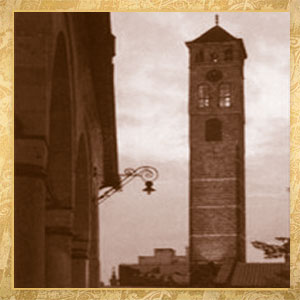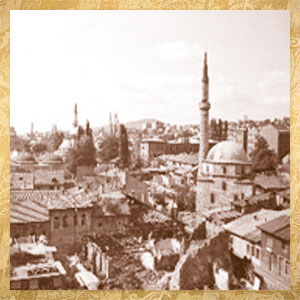 Bascarsija is an old Sarajevan market-place, historical and cultural centre of Sarajevo city. Bascarsija was built in 15th century, when Isa-bey Ishakovic had founded entire city.
Bascarsija is an old Sarajevan market-place, historical and cultural centre of Sarajevo city. Bascarsija was built in 15th century, when Isa-bey Ishakovic had founded entire city.
Word Bascarsija is derived from Turkish word „baš“ which means „main“, thus the whole word „Baščaršija“ means „main market-place“.
Bascarsija is twice smaller than it used to be, because of the fire in 19th century. Communist authorities wanted to destroy it completely in 1940's, but fortunately, they gave up from that plan. Bascarsija is located on north Miljacka riverside, Old Town municipality.
There are several important historical objects in Bascarsija, such as Gazi Husref-bey's mosque and Tower Clock. Today, Bascarsija is main tourist attraction of the city.
Before arrival of Ottomans, the biggest settlement in Sarajevo valley was market-place Tornik, which was located at crossroads, where Ali-pasa's mosque is today.
Bascarsija was founded in 1462, when Isa-bey Ishakovic built a hostelry and number of shops beside it.
In that period, majority population in Sarajevo lived around Careva dzamija (Emperor's mosque). Isa-bey Ishakovic built a bridge over Miljacka river in order to span main Sarajevan settlement with new trade centre of the city, Bascarsija.
Market-place of Bezerdzani was formed around main entrance of Bascarsija. Haberdasher's market-place was built toward the west, while Saddler's or Saraci (present Saraci Street) was built on north side. Mosques are probably the most significant buildings built in this period. Famous Bascarsija mosque was built by Havedza Durak in 1528. Gazi Husref-bey built his mosque in 1530. He also built in the Bascarsija Madrasah (Moslem religious secondary school), library, hammam (Turkish bath), Bezistan (domed market building), Morica Han (inn), Tower Clock and many other objects.
 Gazi Husref-bey is buried in the harem of his mosque, and beside him is a domed burial site of his freed slave and the first mutevelija (mosque superintendent) of his endowment Murat-bey Tardic. Bascarsija was the strongest in the second half of 16th century. There were 80 different crafts, organized in craft-guilds. Bascarsija was organized in the crafts, so shops of one or more similar crafts would have been settled in each street (e.g. Kovaci Street, Kazandziluk Street, Saraci Street, etc.)
Gazi Husref-bey is buried in the harem of his mosque, and beside him is a domed burial site of his freed slave and the first mutevelija (mosque superintendent) of his endowment Murat-bey Tardic. Bascarsija was the strongest in the second half of 16th century. There were 80 different crafts, organized in craft-guilds. Bascarsija was organized in the crafts, so shops of one or more similar crafts would have been settled in each street (e.g. Kovaci Street, Kazandziluk Street, Saraci Street, etc.)
A range of trade objects were constructed in this period (bezistan, hostelries, resting places for caravans – karavansaraji and many other).
Sarajevo was important trade centre in Balkan with three bezistans (Gazi Husref-bey's Bezistan and Bursa Bezistan exist today). There were Venetian and Ragusan colonies in Sarajevo. Around 12,000 trade shops were settled in Bascarsija in that period, but 17th century was not so good for Sarajevo and Bascarsija. Sarajevo was struck by earthquake in 1640 year and affected by fire several times in 1644 and 1656.
However, famous travel writer Evlija Celebija wrote in 1660: „Carsija has a thousand and eighty shops, which are paragons of beauty. Carsija itself is very attractive and built according to a plan.“
Unfortunately, Eugene of Savoy broke in Sarajevo in 1697, fired and devastated entire city. Only several buildings remained. Region of Sarajevo city did not develop too much up to 19th century. During Austria-Hungary occupation in 1878, many foreign architects wanted to transform Sarajevo in a modern European city. The fire, which devastated entire old town except the part that still exists, helped them a lot. Well-known border between Bascarsija and Ferhadija Street emerged in this way.
After liberation of Sarajevo in 1945 year, new city people's board made decision for devastation of carsija with an explanation that old trades centre does not have a role in the modern city. Bascarsija however succeeded to survive and its modern role in the city became a standard in 1970.





